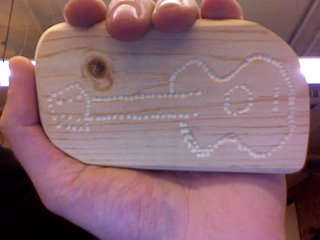Week 3: First Fabrication Foray
The assignment this week called for us to design and build something with the following components: a normal, non-conductive fabric (i.e. cotton), a conductive fabric or thread, and an electric component. Oh, and it had to be wearable.
I had done some design work with sweatbands before, so I opted to continue the trend. I experimented with a few different types of conductive fabric, along with various potential circuits and physical computing components. In the end, I came up with this:


The design was achived using a simple LED, switch state button, conductive thread, and a 3V coin cell battery. The design was relatively simple, as the thread simply acted as the wire would in a normal curcuit.
However, the thread I was using was actually pulled threads off a piece of Organza I had been experiemtning with, since I had no proper thread, I had discovered the possibility taking out the conductive fibers from the Organza and stitching them into the sweatband to create what was essentially conductive thread. Unfortunately, the threads from the Organza were significantly weaker then traditional conductive thread, and while I was able to get the curcuit stitched and present it in class, the thread broke when I attempted to put the sweatband on. In all, it was a very fun project, and really got me excited to work more with conductive fabrics.
I was also inspired by the E-Broidery article, espically the overview of applications section. The fact that there are people out there who are developing and using these materials in such interesting ways just illuminates the face that there are so many possibilities yet to be explored. Being a musician, I particularly enjoyed the musical jacket and keypad idea, though the keypad immediately sparked thoughts of a 'soft' mobile phone or social networking device. (Potential project?)


